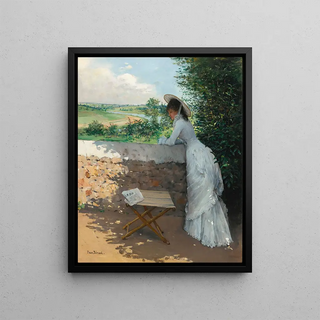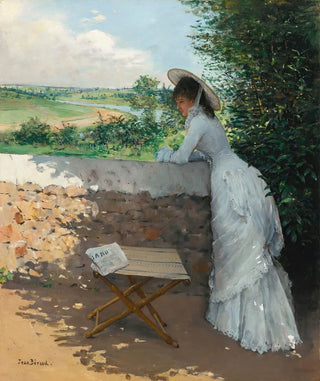Art print | A Dreamy Figaro - Jean Béraud Source: Reproduction | Un Figaro de rêve - Jean Béraud


View from behind

Frame (optional)
In the world of art, some works manage to transcend time and capture the essence of an era. "A Dreamy Figaro" by Jean Béraud is one of those creations that evoke not only the aesthetics of a bygone period but also an atmosphere filled with emotions and stories. Through this canvas, Béraud transports us to a lively Paris, where social life and human interactions take center stage. The meticulous details and the color palette chosen by the artist allow the viewer to feel the magic of a moment frozen in time, while also awakening an insatiable curiosity about the stories behind the painted faces.
Style and uniqueness of the work
Jean Béraud's style is distinguished by his ability to blend realism and impressionism, creating an atmosphere that is both lively and intimate. "A Dreamy Figaro" is no exception to this rule. The work is characterized by a faithful representation of the characters, while incorporating touches of impressionism that inject a dynamic into the scene. The play of light, reflections, and shadows blend harmoniously, offering a depth that invites exploration. Each character is carefully crafted, carrying within them a story, an emotion, a dream. The composition of the piece, with its flowing lines and vibrant colors, evokes a sense of movement, as if one could almost hear the whispers of conversations exchanged in this Parisian café. This ability to capture the essence of everyday life while adding a touch of dream makes this work a true masterpiece.
The artist and his influence
Jean Béraud, an emblematic figure of 19th-century French painting, knew how to establish himself through his unique talent for depicting Parisian life. Influenced by the great masters of his time, he developed a distinctive style that combines meticulous observation with artistic sensitivity. His work bears witness to an era when Paris was the nerve center of arts and culture, and where every street corner, every café, every human interaction held significance. Béraud managed to immortalize this effervescence

Matte finish

View from behind

Frame (optional)
In the world of art, some works manage to transcend time and capture the essence of an era. "A Dreamy Figaro" by Jean Béraud is one of those creations that evoke not only the aesthetics of a bygone period but also an atmosphere filled with emotions and stories. Through this canvas, Béraud transports us to a lively Paris, where social life and human interactions take center stage. The meticulous details and the color palette chosen by the artist allow the viewer to feel the magic of a moment frozen in time, while also awakening an insatiable curiosity about the stories behind the painted faces.
Style and uniqueness of the work
Jean Béraud's style is distinguished by his ability to blend realism and impressionism, creating an atmosphere that is both lively and intimate. "A Dreamy Figaro" is no exception to this rule. The work is characterized by a faithful representation of the characters, while incorporating touches of impressionism that inject a dynamic into the scene. The play of light, reflections, and shadows blend harmoniously, offering a depth that invites exploration. Each character is carefully crafted, carrying within them a story, an emotion, a dream. The composition of the piece, with its flowing lines and vibrant colors, evokes a sense of movement, as if one could almost hear the whispers of conversations exchanged in this Parisian café. This ability to capture the essence of everyday life while adding a touch of dream makes this work a true masterpiece.
The artist and his influence
Jean Béraud, an emblematic figure of 19th-century French painting, knew how to establish himself through his unique talent for depicting Parisian life. Influenced by the great masters of his time, he developed a distinctive style that combines meticulous observation with artistic sensitivity. His work bears witness to an era when Paris was the nerve center of arts and culture, and where every street corner, every café, every human interaction held significance. Béraud managed to immortalize this effervescence






